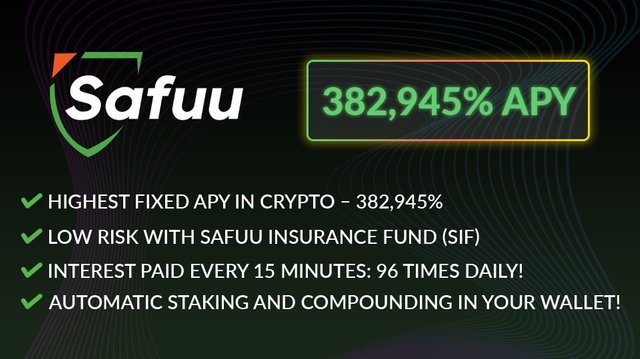SAFUU decentralized blockchain technology

SUMMARY
We all know that not only whale investors, but also those who have little interest in investing their money and want a better return on investment, have only one desire and one project with the lowest risk and highest return. Imagine if we got the same company and, because of blockchain technology, if the project was decentralized. Then it wouldn’t be cool. Yes, I know now you want to know about the project.
What is SAFU?
Safuu is a decentralized financial asset that uses the SAP protocol that rewards users with a continuous, compound interest model. Safuu Auto-Staking Protocol (SAP) is a revolutionary financial protocol that makes staking easier and more efficient while also providing $SAFUU token holders with the most consistent profits in the crypto world.

The SAFU network has the world’s safest cryptocurrency & Fiat Compatible wallet, a multi-functional wallet containing high yield farms and static bet pools that helps you to Store, send, receive, buy, sell, exchange and stake passive income quickly and easily. secures all the advantages of other wallets and centralized/decentralized exchanges, but you keep control of your funds in your SAFUWALLET by Saving your seed phrases, you have control over your funds and with Safe Network Funds is SAFU.
SAFUU KEY FEATURES:
- highest APY.
- Cost.
- AUTO COMBUSTION.
- Stake.
- Liability.
- Locked Liquidity
Highest APY:
Safuu claims Safuu carries the highest average ever on the market. They will give you 382,945,41% for a period of one year. Not only that, they will give us apy gift every 15 minutes. Because it will be a decentralized auto merge system which will generate 15% api and send it to our address every 15 minutes.
Trading Fees:
Their fee system is slightly different, meaning when we buy tokens we have to pay a fee and when we sell our tokens we have to pay a fee. According to them, they will charge us 14% when we buy tokens and then charge us 165 when we sell our tokens. And this fee will not be transferred to the team wallet; in exchange, they will charge this fee, and due to the decentralized mechanism, the amount of the fee will be associated with this feature, allowing users to earn more profit and prices to be more stable.
Here’s where the costs go:
Buy Trading Fees:
4.0% – Liquidity pool.
5.0% – Safuu Insurance Fund (SIF).
2.5% – SAP Protol Rewards Treasury.
2.5% – Burn.
Selling Trading Fees:
4.0% – Pooled liquidity.
5.0% – Safuu Insurance Fund (SIF).
4.5% – SAP Protol Rewards Treasury.
2.5% – Burn.
There is only one burn mechanism. And according to the team, this is an auto-burn mechanism. Let me explain that on other platforms, the team will only decide when the tokens should be burned. But in Safuu, the team has no control over the burning because they don’t have any plans. They put it on the blockchain and the token will be burned when the trade is completed. That means when we place any trade, no matter if it is buy or sell, the decentralized mechanism will automatically burn 2.5% of any trade amount. So this is how the auto-burn mechanism works.
There is no manual betting system. The betting system is automatic. It’s like a holder prize too, but the team claims it’s also automatically staked. For example, if we buy any amount of tokens and hold them for 15 minutes, we will receive our auto-compunding apy amount as an interest rate of 0.02355%.
FOR INFORMATION :
Website: https://safunetwork.net/
Twitter: https://twitter.com/Safunetwork
Facebook: https://www.facebook.com/Safunetwork
Telegram: https://t.me/safunetwork
Medium: https://safuu.medium.com/
DisCord: https://discord.gg/SDEr2SDnzN
Instagram: https://www.instagram.com/Safunetwork1/
Reddit: https://www.reddit.com/u/safunetwork
Ann Thread: https://bitcointalk.org/index.php?topic=5334706
Komentar
Posting Komentar